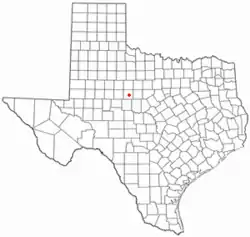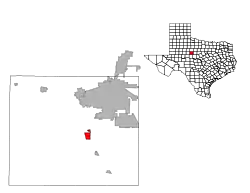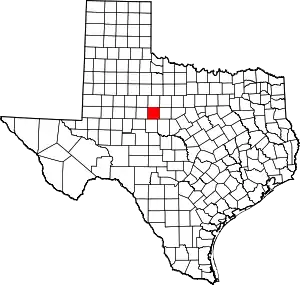Buffalo Gap, Texas
Buffalo Gap is an incorporated town in Taylor County, Texas, United States. It is part of the Abilene, Texas Metropolitan Statistical Area. The population was 464 at the 2010 census.[5] It is the former county seat of Taylor County, having been supplanted in 1883 by the much larger Abilene to its north. Abilene won the referendum to be the county seat by a vote of 905-269.
Buffalo Gap, Texas | |
|---|---|
 Location of Buffalo Gap, Texas | |
 | |
| Coordinates: 32°16′52″N 99°49′45″W | |
| Country | United States |
| State | Texas |
| County | Taylor |
| Area | |
| • Total | 2.43 sq mi (6.30 km2) |
| • Land | 2.43 sq mi (6.30 km2) |
| • Water | 0.00 sq mi (0.00 km2) |
| Elevation | 1,909 ft (582 m) |
| Population (2010) | |
| • Total | 464 |
| • Estimate (2019)[2] | 557 |
| • Density | 228.94/sq mi (88.38/km2) |
| Time zone | UTC-6 (Central (CST)) |
| • Summer (DST) | UTC-5 (CDT) |
| ZIP code | 79508 |
| Area code(s) | 325 |
| FIPS code | 48-11128[3] |
| GNIS feature ID | 1331572[4] |
Buffalo Gap was settled at the site of a natural pass through which bison herds traveled. It was a point on the Great Western Cattle Trail. The community has a few restaurants and art handicraft shops and caters to tourists.[6]
Buffalo Gap is the home of the large Buffalo Gap Historic Village, open year-round to visitors.
History
Buffalo Gap is located at the intersection of Farm-to-Market roads 89 and 1235. It was established in 1857 and procured a post office in 1878. The Callahan Divide, a topographic boundary between the Brazos and Colorado river basins, crosses Buffalo Gap from east to west. Elm Creek once provided a watering hole for buffalo. The Buffalo Gap Highway (Farm Road 89) was surveyed in 1874 and followed the old Center Line Trail, which extended from El Paso to Texarkana on the Texas-Arkansas boundary.[7]
Another major road passed through Buffalo Gap in the direction of the abandoned Fort Phantom Hill north of Abilene. The road forked at Buffalo Gap; one branch led southwest to Pecos County, and the other south to Tom Green County, which includes the county seat of San Angelo. Taylor County history centered upon the gap in the Callahan Divide, where during the 1860s and 1870s, buffalo hunters made winter camp and transported their hides to Fort Griffin northeast of Abilene.[7]
On April 30, 1874, then-Lieutenant Governor Richard B. Hubbard, through his role as the acting Texas secretary of state, approved the selection of Buffalo Gap as the temporary Taylor County seat. In July, the county judge, sheriff, clerk, and county commissioners first met. A general election was held for the first time with eighty-seven male voters. By 1880, Buffalo Gap had 200 people, a drugstore, carriage and blacksmith shop, large hotel, jail, several grocery stores, and a saloon.[7]
Presbyterians established the former Buffalo Gap College, which operated as an institution of higher education from 1885 until 1902, when its charter lapsed and enrollment declined. For a time, Buffalo Gap considered itself the "Athens of the West". The Baptist Church at Buffalo Gap is the oldest of its denomination in Taylor County. In the middle 19th century, Marshall G. Jenkins began a weekly newspaper, the Buffalo Gap Live Oak. A decade later it became the Buffalo Gap Messenger.[7]
Abilene petitioned to become the seat of Taylor County when the Texas and Pacific Railway established its headquarters there. By 1892, Buffalo Gap had decreased in population to 600. In addition to Presbyterian and Baptist churches, there were Methodist, Christian, and Episcopal congregations, as well as a newspaper, sixteen businesses, and a high school in the town. In 1914, the population declined to three hundred, and the number of businesses dropped to seven.[7]
In the 1920s, an "Old Settlers" picnic was particularly well attended, as residents showed their civic-mindedness and nostalgia for the bygone era. Between 1925 and 1980 the population fluctuated between 250 and 400 and the number of businesses between two and twelve. In the 1930s, Buffalo Gap had five churches, a park, and farms and habitations along major roads.
In 1959, the Ernie Wilson Museum of the Old West, named for its benefactor, Ernest "Ernie" Wilson, a Buffalo Gap lawyer, opened its doors. The town jail, displayed at the museum, is made of limestone, with sandstone blocks concave in the center and mortared together with cannonballs to reduce the possibility of a prisoner escaping. The jail is listed in the National Register of Historic Places.[7]
The town noted in the 1960s and 1970s for its restaurants and the fact that it was one of two "wet" spots in Taylor County where alcoholic beverages could be sold. Deutschlander Freshwater Catfish Company and the Bar B Q Barn still operate today.
In 2019, Buffalo Gap recorded a population of 463, eleven businesses, Church of Christ and Baptist churches.[7]
The Shades of Hope Treatment Center in Buffalo Gap specializes in the treatment of eating disorders, and has been featured on The Oprah Winfrey Show.[8]
Geography
Buffalo Gap is located at 32°16′52″N 99°49′45″W (32.281044, -99.829265).[9]
According to the United States Census Bureau, the town has a total area of 2.3 square miles (6.0 km2), all of it land.
Demographics
| Historical population | |||
|---|---|---|---|
| Census | Pop. | %± | |
| 1960 | 316 | — | |
| 1970 | 320 | 1.3% | |
| 1980 | 387 | 20.9% | |
| 1990 | 499 | 28.9% | |
| 2000 | 463 | −7.2% | |
| 2010 | 464 | 0.2% | |
| 2019 (est.) | 557 | [2] | 20.0% |
| U.S. Decennial Census[10] | |||
As of the census[3] of 2000, there were 463 people, 194 households, and 140 families residing in the town. The population density was 201.7 people per square mile (77.7/km2). There were 235 housing units at an average density of 102.4 per square mile (39.4/km2). The racial makeup of the town was 96.76% White, 0.22% African American, 0.22% Native American, 0.22% Asian, 0.65% from other races, and 1.94% from two or more races. Hispanic or Latino of any race were 3.24% of the population.
There were 194 households, out of which 29.4% had children under the age of 18 living with them, 53.6% were married couples living together, 16.0% had a female householder with no husband present, and 27.8% were non-families. 26.3% of all households were made up of individuals, and 10.8% had someone living alone who was 65 years of age or older. The average household size was 2.31 and the average family size was 2.77.
In the town, the population was spread out, with 23.8% under the age of 18, 6.3% from 18 to 24, 23.1% from 25 to 44, 30.5% from 45 to 64, and 16.4% who were 65 years of age or older. The median age was 43 years. For every 100 females, there were 80.2 males. For every 100 females age 18 and over, there were 76.5 males.
The median income for a household in the town was $31,875, and the median income for a family was $34,886. Males had a median income of $26,875 versus $20,500 for females. The per capita income for the town was $14,680. About 6.6% of families and 12.6% of the population were below the poverty line, including 16.5% of those under age 18 and 12.3% of those age 65 or above.
Education
The towns of Tuscola, Lawn, and Buffalo Gap are served by the Jim Ned Consolidated Independent School District based in Tuscola.
Sports
Buffalo Gap is the hometown of University of Texas quarterback Colt McCoy.[11] McCoy lived on a ten-acre spread in Buffalo Gap during his years as the quarterback for Jim Ned High School. His high school coach was his father, Brad McCoy.
During various Super Bowl games of the 1990s, Buffalo Gap experienced "official" name changes, including sign modifications, to show support for the regional Dallas Cowboys. The similarly named city of Buffalo in Leon County in East Texas did likewise.
Buffalo Gap Village offer "Vintage Baseball" as a living history interpretation program. The village recreates the sights, sounds, and smells of an 1880s-era "base ball" (then spelled with two words) game. Interpreters and volunteers illustrate how baseball has changed between 1883 and the present. Teams play on the third Sunday monthly.
Floyd Earl
In 1959, Buffalo Gap incorporated itself as a town in order to establish a municipal water system. The aldermen appointed a part-time city marshal, who began to enforce speed limits. The marshal's salary was based on a percent of the fines collected. When citizens rose up in opposition at the strict enforcement, the marshal resigned. Two more marshals came and went before Mayor C. P. Hendrix retained Floyd Earl, a Buffalo Gap native who described his position, accordingly: "I felt like I was just volunteering for military service." Without a uniform or a police car, the new marshal pointed his flashlight, shouted frantically at speeders, and shot at them when they failed to stop, although he apparently never hit anyone. When some local men threatened to run Earl out of Buffalo Gap, he grabbed the ringleader and vowed to pistol-whip him if he talked back to the law.
When citizens tried to remove Earl, the mayor and aldermen sided with the hard-pressed marshal. Earl collected few fines and faced multiple threats to his authority. "They threatened to kill me Saturday night. At least three times they've tried to run me over when I was on foot. I'll tell you, the only way I'm going to leave is if the town fires me, or if they carry me out to the family plot and bury me." The plight of Marshal Floyd Earl was covered in Time Magazine in 1960.[12]
Notable people
- Aaron Watson, Independent Country Artist. First artist to have a #1 album in country music without a major record label.
- Oliver Lee, marshal, rancher, and gunman. Namesake to Oliver Lee Memorial State Park.[13]
- Rawghlie Clement Stanford, governor of Arizona from 1937-1939.[14]
External links
References
- "2019 U.S. Gazetteer Files". United States Census Bureau. Retrieved August 7, 2020.
- "Population and Housing Unit Estimates". United States Census Bureau. May 24, 2020. Retrieved May 27, 2020.
- "U.S. Census website". United States Census Bureau. Retrieved 2008-01-31.
- "US Board on Geographic Names". United States Geological Survey. 2007-10-25. Retrieved 2008-01-31.
- "Population and Housing Unit Counts, 2010 Census of Population and Housing" (PDF). Texas: 2010.
- Texas Transportation Commission, Texas State Travel Guide, 2007, p. 113
- Handbook of Texas Online, Susan J. Nix, "BUFFALO GAP, TX"
- Davis, Molly (April 4, 2011). "Redlands Woman Battles Addiction on TV". San Jose Mercury News.
- "US Gazetteer files: 2010, 2000, and 1990". United States Census Bureau. 2011-02-12. Retrieved 2011-04-23.
- "Census of Population and Housing". Census.gov. Retrieved June 4, 2015.
- McCoy, Colt (2011). Growing Up Colt: A Father, a Son, a Life in Football. Koyboys. ISBN 9781616266592.
- "TEXAS: Trouble in Buffalo Gap". Time Magazine. Sep 12, 1960.
- McLemore, Virginia T. (Feb 1996). "Oliver Lee Memorial" (PDF). New Mexico State Park Series. New Mexico Geology. Archived from the original (PDF) on 2014-07-13. Retrieved 2013-08-30.
- "Arizona Governor Rawghlie Clement Stanford". National Governors Association. Retrieved Aug 28, 2013.
